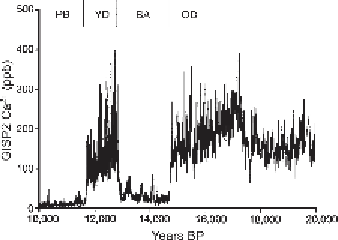Geoscience Reference
In-Depth Information
Figure 10.7.
Calcium concentrations (ppb)
covering the 10-20 ka period, based on
GISP2 ice core data. The sample resolution
is approximately two years through the
Holocene, a mean of 3.48 years within the
YD (Younger Dryas) and BA (Bolling/
Allerod), and three to fifteen years during the
OD (Older Dryas) (from Mayewskii et al.,
1993
, by permission of AAAS).
10.6.2
The Younger Dryas
Figure 10.7
illustrates the YD in terms of high calcium concentrations recorded
in the GISP 2 ice core. The YD was also associated with high dust concentrations
and high magnesium levels. These features imply an intensified circulation over
continental regions and increased aridity. In addition, ammonium, nitrate, sulfate,
sodium, chloride and potassium concentrations rose (Mayewski et al.,
1993
). These
large increases cannot be explained by increased windiness alone. Destruction of
biomass because of colder conditions during the YD could have caused the observed
increase in ammonium.
It appears that NADW formation decreased, associated with cooling in the North
Atlantic and equatorward retreat of the ocean Polar Front. SSTs decreased rap-
idly in the GIN seas by about 6
o
C, returning to near LGM values (Rochon et al.,
1998
). However, a sea ice-free corridor persisted along the Norwegian coast. Some
of the reconstructed oceanic changes in the GIN seas during the YD are illustrated
in
Figure 10.8
. Dates are
14
C years before present, which appear younger than cal-
endar dates (see
Section 10.2.1
). The reductions in August SST and the increase in
the number of months with sea ice cover are especially notable.
Some high-latitude areas experienced a more extreme YD event than others. The
YD was strongly expressed in the North Atlantic and in the Nordic Seas. Western
Norway experienced a very severe change, seen by a considerable halt in disinte-
gration of the ice sheet and the development of extensive moraines. In the west-
ern Nordic seas, there was a slight increase in IRD input (Hebbeln, Heinrich, and
Baumann,
1998
). This compares with little or no change in Svalbard (Birks et al.,
1994
). A cold dry climate in northwest Russia is inferred from pollen records
which indicate that steppe/tundra vegetation was present (Subetto, Wohlfarth, and
Davydona,
2002
). The YD was not well-expressed in the Southern Hemisphere and
most of these records point to warm conditions (Siegert,
2001
).
The transition out of the cold climate of the YD into the Holocene occurred very
quickly (Dansgaard, White, and Johnsen,
1989
; Severinghaus et al.,
1998
). Warming
of 7
o
C occurred in less than fifty years over Greenland. The Greenland climate also
became more humid, most likely owing to the reduction in sea ice cover, allowing
more evaporation and increased precipitation falling as snow (Alley,
1993
). Dust

